Although he was known professionally as William Kraft, anyone who knew him personally called him Bill. Bill had an extended musical career as performer, conductor, composer and teacher and he liked nothing better than telling stories about his experiences.
I knew Bill Kraft for nearly five decades. After years of being my music copying client we became friends. We had a lot to talk about when were together - mostly, of course, we talked about music. His death in February at the age of 98 has affected me deeply.
If you had to choose only one word to describe his music it would quite naturally be percussion. As a performer he excelled as percussionist and later as timpanist. As a composer he will be remembered for bringing modern percussion into the world of classical chamber music and expanding its use in orchestra music. His best known piece is his first timpani concerto. It's entirely possible that the success of that concerto, a beautiful work, has hindered recognition of his numerous other works.
In this article I do hope to offer a balanced view of his music by describing his influences, mentioning a few of his major works and discussing the development of his style and aesthetics. Sometimes hearing and learning about a composer's music will give a sense of that composer's personality. If that happens he would have been very happy.
(Click these links to skip to a particular section. Most links on titles of music take you to recordings. Hover over pictures for a description, click pictures for enlargements. Thanks to Joan Kraft and Jeff von der Schmidt for sharing pictures.)
William Kraft started playing jazz as a teenager in San Diego. Later he visited the famous club scene on Central Avenue, even playing after-hours jam sessions there. He earned money for his studies at UCLA by playing in a trio at a nightclub in Inglewood. Drafted by the Army and dreaming of being a P38 pilot, he was assigned instead to a military band in Arizona where he honed his abilities as a dance band arranger. One of his stories was about doing an arrangement of the Juan Tizol tune Perdido and showing it to band leader Benny Carter -- who rejected it because of the complexity. Years later, the two met again at an awards banquet and Carter still remembered the arrangement.
His love of jazz was balanced by a fascination with the classics. In 1948 he was accepted to Tanglewood (playing timpani and auditing Leonard Bernstein's conducting classes) and the whole realm of classical music opened for him. Realizing that the education he needed was in New York City, he enrolled at Columbia. There he studied composition and conducting while taking timpani lessons at Juilliard. He told stories about subbing as a mallet player in Salome and Elektra at the Metropolitan Opera. He was an enthusiastic, eager and talented student. New York City in the early fifties was a hotbed of modern musical creativity and Bill found himself right in the middle of it. Right where he wanted to be.
Bill liked to tell stories about his education, often mentioning particular courses or instructors. During his student years he rubbed elbows with the cream of America's avant-garde musicians, names like Lou Harrison and Henry Cowell. My favorite example: in 1951 he performed in the premiere of John Cage's Imaginary Landscape No. 4 (that's the piece for 12 AM radios).
We rehearsed at Cage's house in Greenwich Village. . . . First of all, all of the furniture in his apartment was cut down, Japanese style. He had tatami mats, we had to take off our shoes and we walked in and we sat on the floor when we played the radios. The kitchen sink was overflowing with dirty dishes and pots and pans and things. A girl asked him during one of the rehearsals, she says "Mr. Cage, my radio makes no sound unless you go past 3 and in the part it never goes past 3." And he said "Some of the most beautiful portions of the gothic cathedral are those which are invisible." And that's when I began to realize what a brain this man had.
And so I've reduced his entire career into one paragraph. More details can be found in the obituaries in the Los Angeles Times or the New York Times or at the websites of the UCSB Dept. of Music or his publisher Theodore Presser (click on 'about') or the Los Angeles Philharmonic or the Percussive Arts Society.
Bill has said that it had always been his dream to live as a composer. In the early sixties this started to become reality.
Because he had destroyed his student works, the earliest William Kraft pieces we have are for percussion ensemble. Remo Belli (owner of Remo drums) asked Bill to compose music for a new line of synthetic drum heads. The result was Suite for Weather Kings for four players, premiered in 1958 - eventually expanded with more movements and instruments beyond drums to become his Suite for Percussion. About this time Bill formed the Los Angeles Percussion Ensemble (known originally as the First Percussion Quartet and at least once, on a Monday Evening Concert, as the William Kraft Percussion Ensemble) to perform his own and other composer's percussion music. A list of Bill's works for percussion may be found here.
He was asked by then LA Phil. Music Director Georg Solti to compose a new orchestra piece. In 1962 (the year he became the orchestra's timpanist) he finished Concerto Grosso, a three movement work scored for orchestra with a concertino of flute, bassoon, violin and cello soloists. It got good reviews and was recorded by the Louisville Orchestra on the flip side of a Walter Piston symphony. The liner notes describe the music: "while the pitch organization is serial, the rhythms are relatively uncomplicated and are freely invented by the composer." To me Concerto Grosso seems decidedly neo-classic in a style with extra touches of percussion, evoking neoclassical composers of the time such as Irving Fine or Harold Shapero. It's the only piece I know which can be described as "early Kraft".
When I first learned about Concerto Grosso the only way to hear it was to buy a used copy of the disc -- I did that and then gave it to Bill as a gift. I was curious about what he would think of the piece now. Bill seemed to have disowned it. He hadn't heard it in years and resisted listening. I now suspect this was because he had dedicated Concerto Grosso to his ex-wife. However, it's a fine piece which deserves at least an occasional concert hearing.
Bill's next big orchestra work, in 1964, was Concerto for Four Percussion Soloists and Orchestra . In this piece Bill has moved the entire percussion section out of hiding behind the rest of the orchestra up to the front, sonically if not physically. Both this piece and Concerto Grosso are in three movements and feature four soloists. The later piece however has a much freer formal structure and uses far more percussion. The printed score begins with what would become a hallmark of Bill's music: a full page glossary precisely describing all the required percussion equipment and the specialized performance techniques. Here we find unmistakable signs of what the musical style of William Kraft would become.
Bill wrote this about Concerto for Four Percussion Soloists and Orchestra:
"What I am trying to do is to give the percussion players, at long last, an opportunity to express their musical selves, something which has hitherto been impossible because there is no body of literature such as exists for all the other instruments - no sonatas, no quartets, no trios." (found on the Theodore Presser website)
Additionally writing for percussion gave Bill a way to express his own musical self. This was always a priority for him. He loved composing and tried to begin every day doing just that. In a recommended interview Bruce Duffie asked him whether he wrote music to be accessible:
No, that’s never in my mind. I write to say what I want to say. If I had a different sort of ear, an ear like, say, Elliott [Carter]’s — and by that I mean the inner ear that dictates what is to be done — then I would do something different. But I’m trying to do what I feel is me.And then Bruce asked if Bill found writing music fun:
Well, it’s my life! I love it! It’s essential. It’s just automatic for me. It’s just always right. I don’t think about anything else, really. I do think about other things, of course, but that’s the first thing. I compose in the morning, and hopefully if that goes well, the day is just great. Everything else rolls along nicely.
Some of Bill's works involve political themes. Bill was passionately anti-war and pro-civil rights. This is first revealed in Contextures: Riot Decade 60s, composed in 1967 during a time of great civil unrest in the U.S. It's an all instrumental piece but it does have, quite uniquely for his music, an off-stage jazz ensemble, which must include, as Bill specifies in the score, "an accomplished jazz drummer". He described the composition process:
"As the work progressed the correspondence between the fabric of music and the fabric of society became apparent and the allegory grew in significance. So I found myself translating social aspects into musical techniques."
On the morning of the first performance, April 4, 1968, Martin Luther King was assassinated. Bill added a special dedication to King, writing in the score that he felt King "represented most profoundly what Contextures is really about"
Contextures became the name of a series of pieces. Contextures II: The Final Beast is a sprawling cantata filled with anti-war poetry. A Kennedy Portrait, subtitled Contextures III, is a setting of speeches by John F. Kennedy for narrator and orchestra commissioned on the 25th anniversary of JFK's assassination. It is clearly modeled after Aaron Copland's Lincoln Portrait. The text deals with issues such as the role of the arts in society and equal rights. It ends with excerpts from the speech Kennedy intended to give on November 22, 1963. Listening to this piece recently, I found it a surprisingly strong work - filled with messages we in the U.S. still need to hear.
Finally, in 1991, Bill composed Songs of Flowers, Bells and Death, Requiem for Victims of All Wars, Contextures IV. Quite the title. The piece is scored for chorus and an orchestra of twelve percussionists. The text is drawn from poetry by Indian, Japanese and English authors plus Catholic, Jewish and Native American prayers.
The harmonies of William Kraft can often seem quite thick and dissonant, his melodies angular and jagged. Once I sat next to him at a concert of his music and at one moment the percussionist played tuned gongs outlining a major triad. I mentioned how surprising this was and he replied "It was a mistake" - meaning the performer's error. He might have been called a modernist by people who didn't mean that as a compliment. It would be easy to assume that William Kraft was a serial composer.
That assumption would be wrong. American composers of his generation had to address the techniques of serialism, one way or another, either adopting, or modifying or rejecting. This became particularly intense when composers like Aaron Copland, famous for his Americana, or Igor Stravinsky, famous for his ballet and neoclassic works, adopted serial techniques in their later music. Bill used serial methods in his music at times, of course - pretty much everyone did that - but he was not one to give up his personal sense of how music should sound. He once said to me,
"Like many Americans I cheated on [Serialism] - Stravinsky said he cheated, Lukas Foss said he cheated and I really cheated."
When asked about his harmonies he'd talk about his debt to Maurice Ravel and to American jazz. He called this combination of traditions American Impressionism. While he knew what he meant by the term, I found it hard to understand in any practical sense, especially when I sat down to analyze his chords.
In any case, Bill loved the harmonies used by French impressionist composers which he felt had been adopted by many jazz pianists. He worked to combine those two traditions. There are moments in his music which recall French impressionism, when a listener can imagine pastoral, dreamy landscapes.
However, Bill's music never, ever sounds like jazz. He had other aesthetic considerations which prevented that, including the very avant-garde notion that a composer should avoid all forms of repetition. Here are some things he told me:
"My style is no repetition, constant variation. I look at really good music - you know the masters . . . and there's so much more variation than one suspects"
"My main concern was that [my music] had continuity, that it was not predictable, that it was organic. All these things. I didn't like to pre-suppose anything."
"I wanted to have the harmonic world of impressionism coupled with the rhythmic thrust of American jazz - but not to have it obvious."
The use of percussion contributes to this reputation for dissonance. Many percussion sounds are filled with overtones; these are often not in tune. Cymbal scrapes and other techniques can have an eerie electronic feeling. Bill went to great lengths to specify exactly what he wanted the performer to do, which mallet to hold in which hand, which part of the cymbal to strike. One cool technique was to ask for the vibraphone to be played with cluster mallets - specially designed to strike an entire octave of notes (or more) all at once -- clangorous and loud. Another favorite of mine - a spring coil (yeah, an auto part) - soft and filled with subtle allusions.
Bill Kraft did not - would not - write down to his audience. In 2007 he penned an online response to a New York Times critic who had suggested that composers should do exactly that. He called it The Audience Is Not The Only Arbiter. Here are several excerpts:
What is the purpose of the “gift” if the composer doesn’t follow his muse? Where would style and expression be? Mr. Holland speaks of Mozart and Haydn writing for patrons, but then, what to make of Glenn Gould’s statement that because of the patronage system we never got the best of Mozart (as unbelievable as that may be!)?
Schoenberg wrote in Style and Idea that a composer composes because he must, not because he can. A composer writes to express himself and his ideas to the best of his ability. He may want to communicate and share those elements with his public. He may not, but odds are that he would like to. The ivory tower is a myth.
In the commercial arena, of course, it is easy to determine the taste of the public, but for the concert hall—even if one wanted to write for the public—how would that be determined, and by what segment of the public? Would it be those who are experienced listeners or those who are new to the game? Consider the many backgrounds that make up the audience.
One last quote, this from a person who during his lifetime was simply a member of the audience, John F. Kennedy: “In a democracy…the highest duty of the writer, the composer, the artist is to remain true to himself and let the chips fall where they may.”
Encounters is a long series of William Kraft chamber pieces. Each of them (with one exception) features percussion as equal partner in the music.
The one without percussion is Encounters II for solo tuba. That one - confusingly - was the first to be composed in 1967 and was premiered at a concert series here in Pasadena entitled Encounters. The name stuck through seventeen Encounters pieces, the last written in 2012.
Nothing else defines the music of William Kraft like the Encounters series. Fortunately a large chunk of the entire series was recorded by the Southwest Chamber Music Society with the Tambuco Percussion Ensemble in 2008. This well produced album of high quality performances made Bill quite proud. You can read about the Encounters series at Southwest's website (click on "program notes" for a description of each piece. This excellent album is still available from Cambria Music or downloadable from the usual suspects.)
In 2007, when Southwest performed these works in concert, I wrote about the Encounters series here on Mixed Meters. In that post I talked about some of Bill's percussion techniques and ranted about why Bill's music is not particularly in sync with the current age of minimalist music.
Bill added the subtitle The Grand Encounter to his Concerto No.2 for Timpani and Orchestra. The soloist, playing 15 different drums arranged in a circle, spins around quite a lot. The link is a multi-camera concert video which really shows the dizzying spins required of the performer. Notice that James Boznos plays from memory - because there's no place to put the music. Here's a picture of Bill posing with all the drums.
The cover page of the orchestra score mimics the timpani setup. Below that picture is a snapshot I took of the San Francisco Symphony rehearsing for the very first performance of this piece in 2005. The soloist is behind the conductor; note the thirty-some tuned gongs hanging just to the right.
Bill Kraft wrote a large body of music over nearly 60 years and in this post I'm trying to give an overview of much of it as I can. I have to confess that there's a lot of music in Bill's catalog which I don't know - early works, pieces that were never recorded, pieces that Bill wasn't happy with and never spoke about. As I've researched this article I keep finding titles I've never even heard of before. Maybe there's an eager young musicology student out there somewhere who wants to do a dissertation listing all the music of William Kraft. I sure hope so. (But wait. I found one about all of Bill's percussion music but that suffers from having been written more than twenty years too soon.)
I have more things to mention. To me these seem important or revealing or just interesting. So get ready for a section of short subjects.
- In Vintage Renaissance (a piece commissioned by the Boston Pops, later revised for wind symphony) Bill included two pieces of Renaissance music, making that piece one of his most accessible.
He went one step further in Contextures II, The Final Beast, calling for a separate Old Music Group (presciently abbreviated as OMG). While the instrumentation he asks for is flexible, imagine a small ensemble of viols and lute and maybe a rebec or crumhorn or two, sitting in the midst of the orchestra playing a John Dowland tune completely independent of the conductor. Here's an OMG entrance from the orchestra score - they are playing quarter note equal 116 while the orchestra (still following the conductor) is plodding along at quarter equals 50:
- Bill wrote an opera, Red Azalea. It's based on a novel by Anchee Min about her experiences during the Chinese Cultural Revolution. The subject matter took on a very personal aspect for Bill because it mirrored the experiences of his wife, composer Joan Huang. The erhu (a Chinese bowed string instrument) is featured prominently.
The opera was performed in 2003 at UC Santa Barbara and you can read the LA Times review or this pre-concert piece in the Santa Barbara Independent. In this picture of Bill and Joan you can see him on the cover of the Independent hanging behind them, only slightly obscured by a beautiful pink orchid.
- Bill often found inspiration by using another composer's work as a model for his own. I've already mentioned A Kennedy Portrait.
Another such piece is the song cycle Settings From Pierrot Lunaire for soprano and chamber ensemble. It started as part of a multi-composer project instituted by Leonard Stein at USC's Schoenberg Institute intended to set the remaining poetry by Albert Giraud that Arnold Schoenberg did not include in his own Pierrot Lunaire. Bill took the idea and ran with it, setting additional poems and adding interludes and later expanding the chamber group into full orchestra. In deference to Schoenberg, Bill said that he expanded his harmonic language in Settings From Pierrot Lunaire - from his usual 7-tone scale (raised fourth, lowered seventh) to all twelve notes.
- Bill wrote a lot of concertos I haven't mentioned yet. There's his Piano Concerto (a work broadcast nationally over PBS with Mona Golabek and Zubin Mehta), Veils and Variations (for french horn, written for Jeff von der Schmidt), the intriguingly titled Andirivieni: Concerto for Tuba with 3 Chamber Groups and Orchestra (written for Roger Bobo of the LA Phil) and his English Horn Concerto (written for Carolyn Hove also of the LA Phil, shown here in rehearsal with the composer and Esa-Pekka Salonen).
There are a bunch of Kraft percussion concertos and many seem to have similar names. For example I've seen a listing for Configurations, Concerto for Four Percussion Soloists and Jazz Orchestra, with an orchestra of flute, two reeds, brass, electric guitar, piano and bass. I would love to find out if it's related to Concerto for Four Percussion Soloists and Orchestra written just a few years earlier. According to a review I found, the music itself is not jazzy. There's another percussion concerto: Triangles for solo percussion and 10 players. And did I mention that he wrote not one, but two timpani concertos?
- I mentioned that Bill composed the soundtracks for several movies and television shows. Best known is Ralph Bakshi's Fire and Ice in which Bill, while still writing his own music, throws in all the requisite big, exciting adventure movie moments. His (probably incomplete) list of movie credits as composer, performer and conductor (including scores by composer Patrick Doyle) can be found at IMDB.
Another movie he scored was called Bill (it starred Mickey Rooney as someone else named Bill). Our Bill got credit at the end:
- In 1987 Bill was commissioned to provide music for a light sculpture Sky's the Limit in a 750-foot long underground tunnel at the United Airlines terminal in Chicago. He wrote about an hour of music which was performed on a digital synthesizer. That would have been a very exciting sound at that time. It sounds quite dated today.
Sky's the Limit is unique because it's the only music of William Kraft that could be described as either minimalist or environmental. Simple melodies repeat and he clearly had no expectation that listeners would hear the entire work. He wrote it in two large sections, slow (for the ends of the tunnel) and fast (for the middle).
After a while Bill's music was removed from the tunnel in favor of George Gershwin but Sky's the Limit earned a permanent place in his CV. Bill tells more about Sky's the Limit at the end of this excellent interview with Bruce Duffie.
- Among the best known works of William Kraft are two pieces for solo percussion - French Suite and English Suite, both multi-movement works patterned after their Bachian namesakes. Why are they well known? Because they are often programmed on recitals by college students. Intended as pedagogical works, they are Bill's way to give young percussionists a taste of the classical music he loved.
In the music of William Kraft the drums get to play melodies, just like other instruments. I think the Gigue from French Suite is a great example of that.
- Bill is well known for having edited the percussion part to Igor Stravinsky's L'Histoire du soldat, the very first chamber work with multiple percussion, premiered in 1918. Bill recorded this piece, with Stravinsky conducting, in 1961, He used his access to the composer to resolve confusion in the notation. As I've said, Bill idolized Stravinsky.
In Dorothy Crawford's exceptional history of the Monday Evening Concerts (Evenings On and Off the Roof), she quotes Bill's story about a MEC performance of his Double Trio, in which a drum cadenza went on so long that Stravinsky left the hall and went home. Bill continues the story:
The next night Stravinsky stopped to tell me how much he liked the piece. Then he said "I'm sorry I had to leave. I don't have the energy to sign the autographs. And also, I must tell you, I don't like drum solos." Little did he know that everything I've done for multiple percussion is patterned after L'Histoire du soldat. (p.229)
- Many of Bill's pieces have sections which give players the freedom to perform his material as they choose, for example, when to make an entrance or a series of small musical cells that can be performed in any order.
Here's a musical example. This is from Bill's 2013 percussion quartet entitled Fore! For Four. The top half is his manuscript, the bottom half is the engraved version of the same music. On the lowest staff you can see individual cells, the order and repetition of which is decided by the player. Notice that the manuscript has a cell with just a question mark inside. That didn't make it into the final version.
Bill expanded on this idea of freedom for the performers by composing two works entirely in graphic notation. These are called Colorations and Kandinsky Variations. Performers are required to choose the actual sounds, following the graphic outlines. The score to Kandinsky Variations, shown below, was prominently displayed on the wall in Bill's studio. The colors represent different types of instrumental sounds - I think he called the red and blue "hot" and "cold".
My object in writing this little essay has been to somehow speak of all the elements of the music of William Kraft - as I know them - in one go. As I worked on it and learned new things about him, he seemed to grow bigger and bigger as a musician.
He believed that the best composers revealed their inner selves through their music. If that's the case, knowing the full scope of his music will help to know the full scope of the man. As a person he had a lot of facets and his music does as well. He was a good man and a great musician. And I feel privileged to have known him.
If you spoke with Bill about his music for any length of time you'd soon hear him talk about beauty. He strove for that quality in his music. He often said
"If I think it's beautiful there must be someone out there who also thinks it's beautiful"
To those ends, here's a quote from Bill's program notes to his piece The Sublime and The Beautiful (1979, songs for tenor and ensemble with texts by Dostoyevsky and Rimbaud). I think he sums things up quite nicely.
"In an age characterized by violence, tension and technology, I felt that the idea that art should mirror its age has dubious merits. This approach may serve history as a reflection of the time, but it serves humanity less well. Therefore I wanted to look into beauty: how the artist got in touch with his creative self, and how the artist described beauty itself."
The subject of beauty brings me to the one essential William Kraft masterwork which so far I've only alluded to: his first Concerto for Timpani and Orchestra, written in 1983. It's his most often performed large work. Also the most accessible and probably the most representative of his music. In my mind it certainly qualifies as beautiful; even Jonathan Gold called it gorgeous. Bill managed to perfectly blend his propulsive rhythmic sense with his impressionism-inspired harmonies with his total understanding of the instrument with his knowledge of the orchestra to write one really wonderful concerto.
And it's really fun to watch the soloist. In this live concert video there's just one camera angle, trained on soloist Randy Max (who, during the final applause, demonstrates that just how many bouquets is too many). The performance is excellent; alas, the sound quality could be better.
This piece is in the conventional three movement format. It begins with the soloist playing with gloved hands; the gloves have different material on different fingers - soft felt or hard leather - to create fine gradations of sound quality. Later the gloves come off and the soloist plays with bare hands. The glissando-filled middle movement is entitled Poem for Timpani, Two String Orchestras, Celeste and Percussion. Bill added In Memory of My Mother to the title of that movement; she had passed away while he was composing. He asks for the two string orchestras to be seated antiphonally if possible. In the third movement Bill calls for the timpani to be muted - and suggests that scores to Haydn string quartets would make perfect timpani mutes.
If you've never heard the music of William Kraft, this concerto is an excellent place to start. However it is not a good place to stop your listening. He spent his entire career expanding the use of percussion in classical music, drawing on the past, present and future of music to create a unique body of work. I hope my descriptions here will inspire you to explore further because there are many rewards for careful, curious listeners. Enjoy.

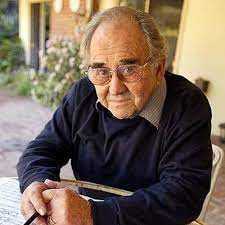
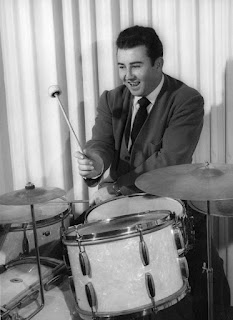






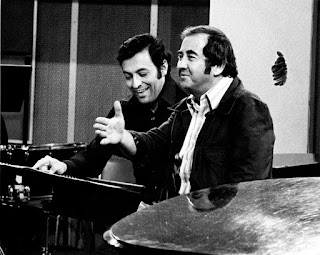



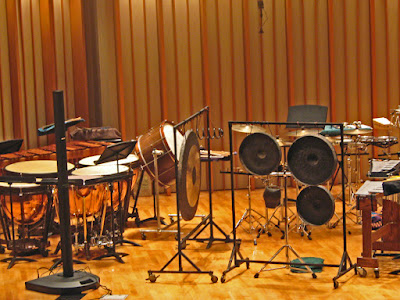

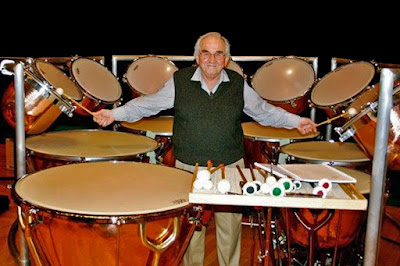
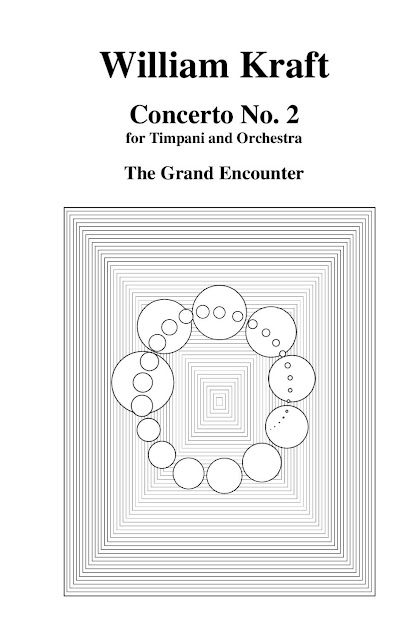

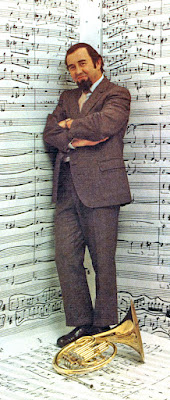

.jpg)
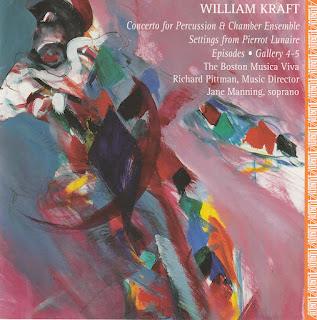
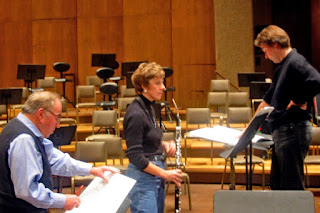

.jpg)
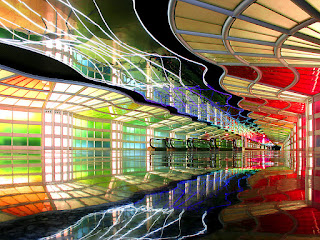
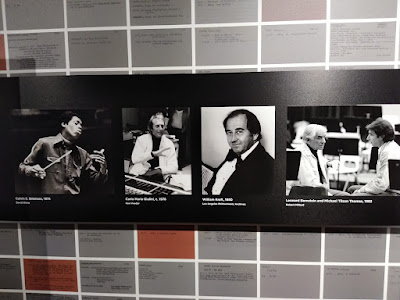
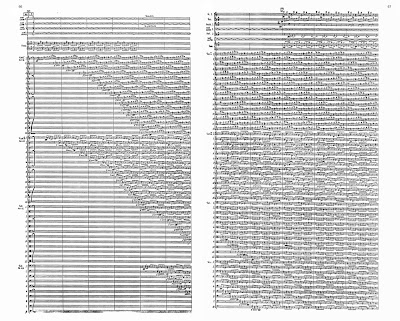
%20by%20William%20Kraft,%20manuscript%20and%20engraving.jpg)


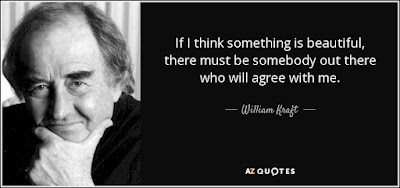
No comments :
Post a Comment